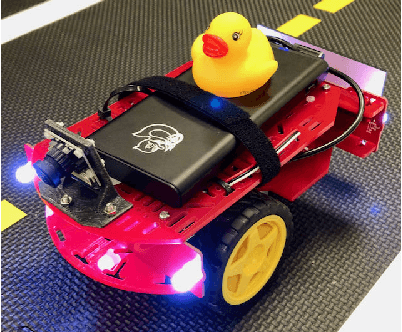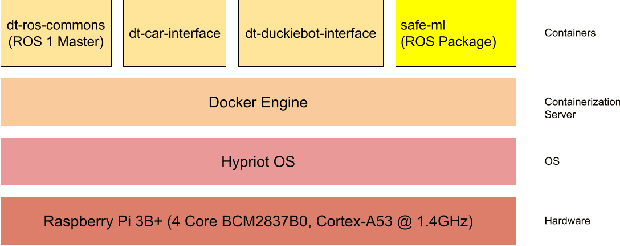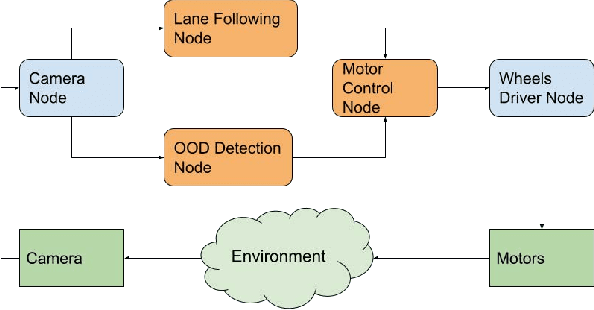Yeli Feng
Improving Variational Autoencoder based Out-of-Distribution Detection for Embedded Real-time Applications
Jul 30, 2021



Abstract:Uncertainties in machine learning are a significant roadblock for its application in safety-critical cyber-physical systems (CPS). One source of uncertainty arises from distribution shifts in the input data between training and test scenarios. Detecting such distribution shifts in real-time is an emerging approach to address the challenge. The high dimensional input space in CPS applications involving imaging adds extra difficulty to the task. Generative learning models are widely adopted for the task, namely out-of-distribution (OoD) detection. To improve the state-of-the-art, we studied existing proposals from both machine learning and CPS fields. In the latter, safety monitoring in real-time for autonomous driving agents has been a focus. Exploiting the spatiotemporal correlation of motion in videos, we can robustly detect hazardous motion around autonomous driving agents. Inspired by the latest advances in the Variational Autoencoder (VAE) theory and practice, we tapped into the prior knowledge in data to further boost OoD detection's robustness. Comparison studies over nuScenes and Synthia data sets show our methods significantly improve detection capabilities of OoD factors unique to driving scenarios, 42% better than state-of-the-art approaches. Our model also generalized near-perfectly, 97% better than the state-of-the-art across the real-world and simulation driving data sets experimented. Finally, we customized one proposed method into a twin-encoder model that can be deployed to resource limited embedded devices for real-time OoD detection. Its execution time was reduced over four times in low-precision 8-bit integer inference, while detection capability is comparable to its corresponding floating-point model.
WiP Abstract : Robust Out-of-distribution Motion Detection and Localization in Autonomous CPS
Jul 25, 2021

Abstract:Highly complex deep learning models are increasingly integrated into modern cyber-physical systems (CPS), many of which have strict safety requirements. One problem arising from this is that deep learning lacks interpretability, operating as a black box. The reliability of deep learning is heavily impacted by how well the model training data represents runtime test data, especially when the input space dimension is high as natural images. In response, we propose a robust out-of-distribution (OOD) detection framework. Our approach detects unusual movements from driving video in real-time by combining classical optic flow operation with representation learning via variational autoencoder (VAE). We also design a method to locate OOD factors in images. Evaluation on a driving simulation data set shows that our approach is statistically more robust than related works.
Embedded out-of-distribution detection on an autonomous robot platform
Jun 30, 2021



Abstract:Machine learning (ML) is actively finding its way into modern cyber-physical systems (CPS), many of which are safety-critical real-time systems. It is well known that ML outputs are not reliable when testing data are novel with regards to model training and validation data, i.e., out-of-distribution (OOD) test data. We implement an unsupervised deep neural network-based OOD detector on a real-time embedded autonomous Duckiebot and evaluate detection performance. Our OOD detector produces a success rate of 87.5% for emergency stopping a Duckiebot on a braking test bed we designed. We also provide case analysis on computing resource challenges specific to the Robot Operating System (ROS) middleware on the Duckiebot.
* 6 pages, 8 figures
Towards Robust Classification with Image Quality Assessment
Apr 14, 2020



Abstract:Recent studies have shown that deep convolutional neural networks (DCNN) are vulnerable to adversarial examples and sensitive to perceptual quality as well as the acquisition condition of images. These findings raise a big concern for the adoption of DCNN-based applications for critical tasks. In the literature, various defense strategies have been introduced to increase the robustness of DCNN, including re-training an entire model with benign noise injection, adversarial examples, or adding extra layers. In this paper, we investigate the connection between adversarial manipulation and image quality, subsequently propose a protective mechanism that doesnt require re-training a DCNN. Our method combines image quality assessment with knowledge distillation to detect input images that would trigger a DCCN to produce egregiously wrong results. Using the ResNet model trained on ImageNet as an example, we demonstrate that the detector can effectively identify poor quality and adversarial images.
 Add to Chrome
Add to Chrome Add to Firefox
Add to Firefox Add to Edge
Add to Edge